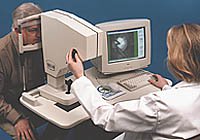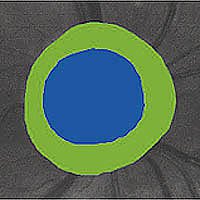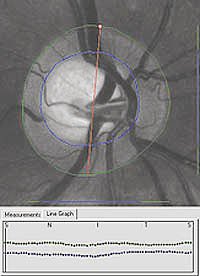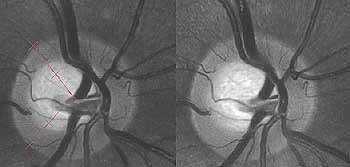Discam data is accurate and reproducible, studies show
The system enables a diagnostic procedure known as Chevron cup-to-disk analysis.
 ---Discam used on patient’s left eye.
---Discam used on patient’s left eye.
SAN ANTONIO — Early detection and management of glaucoma can minimize damage caused by the disease, but long before visual fields are affected, optic nerve head injury is well underway. By precisely measuring optic disk cupping, a new digital camera called the Discam (Marcher Enterprises, Hereford, United Kingdom) offers clinicians an earlier, more objective look at glaucomatous damage and a precise way to track disease progression.
With Discam, the clinician or nurse is able to see the nerve head in detail. Discam stereo images are displayed live on a PC monitor during capture, which is accomplished with low-light intensity for patient comfort. Comparison with previous images is immediate.
Missed diagnoses
 ---Horizontal and vertical cup/disc ratios are measured by taking the maximum dimension from side to side and top to bottom of both cup and disc. This allows for appropriate measurement of eccentric or asymmetric cups and discs.
---Horizontal and vertical cup/disc ratios are measured by taking the maximum dimension from side to side and top to bottom of both cup and disc. This allows for appropriate measurement of eccentric or asymmetric cups and discs.
Often, normal tension glaucomas are missed in tests by air puff tonometers. Changes in the optic nerve head can usually be detected before irreversible loss of visual field, and treatment can preserve sight.
 ---Method of calculation shows the area ratio (the area of the cup divided by the total area of the disc) and the perimetric ratio (the cup perimeter divided by the disc perimeter).
---Method of calculation shows the area ratio (the area of the cup divided by the total area of the disc) and the perimetric ratio (the cup perimeter divided by the disc perimeter). The Discam, which Marcher claims captures stereo images of the optic nerve head faster than laser scanning systems, enables a diagnostic procedure known as Chevron cup-to-disk analysis. Chevron analysis uses optic disk photographs to identify key vascular landmarks with digital stereo images, and then assesses cupping based on changes in relation to those landmarks.
Nasal, superotemporal and inferotemporal reference points are manually identified on each disk margin with a cursor by means of a mouse. The superotemporal and inferotemporal points are frequently associated with visual field loss.
Clinicians begin Chevron analysis by estimating the position of the cup base along each of the two axes, subtended between the nasal reference point and two temporal disk rim points. Alternately, a central reference point within the disk may provide the axis for a triad of lines — one to the nasal landmark and two toward the superotemporal and inferotemporal reference points. Placement of these markers should maximize the avascular alleyways and subtend maximally the anticipated zone of superior and inferior cupping. The Chevron ratio is the total length of the axes at the base of the cupped portion of the disk, over the sum of the axes to the disk margin.
Four tests
 ---Display of results.
---Display of results. William E. “Rick” Sponsel, MD, of the University of Texas Health Center, conducted several separate tests of the Discam and the Chevron method.
In the first trial, three observers measured distances from nasal to inferotemporal disk rim reference points from 20 pairs of stereo images, in increments of 100 µm granticles. Measurements from these axes to the cup base were performed on three different occasions for each pair of images by each observer. Researchers found that the Chevron ratio is a highly reproducible method for analyzing glaucomatous optic neuropathy by using defined vascular landmarks and the temporal border of the cup.
The second test determined cupping progression by manual Chevron assessment. Disk-center fundus photos were taken at baseline and followed up for between 14 and 34 months. Results indicated that while Chevron ratios increased only a small amount, there was indication that actual changes were statistically significant, indicating that system is capable of accurately tracking change over time.

 ---Cup/disc ratios are measured at 5° intervals. A polar plot of the disc and cup perimeters (X axis) shows the neuro-retinal rim shape.
---Cup/disc ratios are measured at 5° intervals. A polar plot of the disc and cup perimeters (X axis) shows the neuro-retinal rim shape. In the third test, designed to assess the automated mode of the Discam, four surgeons acquired 23 simultaneous stereo images of eyes with glaucoma. One surgeon marked nasal, superotemporal and inferotemporal reference points on each disk margin with a cursor and mouse. All four then estimated the position of the cup base along each of the axes. The Discam computer provided its measurements for each axis, which were tabulated by a neutral observer who randomized cursor settings between each reading.
Dr. Sponsel found that Chevron ratios uniformly ranged from 0.3 to 0.8 for all 23 eyes. Reproducibility data using the Discam was twice as precise as manual measurements.
“The Discam, which acquires and analyzes optic disk images in far less time than required for the awkward tabulation of comparable data from stereo disk transparencies, is capable of providing detailed and clinically relevant data at low expense for clinical documentation and monitoring of glaucomatous neuropathy,” Dr. Sponsel told Ocular Surgery News.
In the final test of the Discam, Dr. Sponsel and his colleagues compared Discam results with field tests and discovered an association between visual field damage and Chevron cup-to-disk ratios in a test population of 574 patients, suggesting that the machine might be able to objectively relate morphologic change to subjective changes in vision.
 ---Clinicians begin Chevron analysis by estimating the position of the cup base along each of the two axes, subtended between the nasal reference point and two temporal disk rim points.
---Clinicians begin Chevron analysis by estimating the position of the cup base along each of the two axes, subtended between the nasal reference point and two temporal disk rim points.
For Your Information:
- William E. “Rick” Sponsel, MD, can be reached at the University of Texas Health Center, 7703 Floyd Curl Drive, San Antonio, TX; (210) 567-8401; fax: (210) 567-8413. Dr. Sponsel has no direct financial interest in any of the products mentioned in this article, nor is he a paid consultant for any companies mentioned.
- For more information on the Discam, contact Richard Walker or Tim Dawson at Marcher Enterprises Ltd., Clearview Court, Twyford Road, Rotherwas Industrial Estate, Hereford HR2 6JR, England; (44) 1432-278-400; fax: (44) 1432-354218; e-mail: RW@marcher.co.uk.
